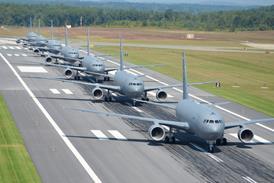Honeywell is investigating the potential of using ceramic matrix composites (CMC) in its military helicopter engines, as it looks to follow the lead of GE Aviation, which pioneered use of the material.
CMCs – which combine light weight with high heat resistance – are being deployed by GE in the combustor liners, shrouds and high-pressure turbine nozzles on its GE9X engine for the Boeing 777X, and shrouds on the Leap-series powerplants produced by its CFM International joint venture with Safran.
Honeywell is also investigating CMC possibilities. Chief technology officer Bob Smith, speaking during a Honeywell media event, said potential applications were “mostly in the military helicopter business” on “high-cycle engines”.
Far and away Honeywell’s biggest selling military helicopter engine is the T55 turboshaft that powers the Boeing CH-47 Chinook. In addition, its LHTEC joint venture with Rolls-Royce produces the CTS800 series for platforms including the AgustaWestland AW159 Wildcat.
Mike Bevans, senior director of technical sales business and general aviation at Honeywell, says one potential application it has identified is for the engine exhaust tail cone with other components under consideration.
Bevans stresses only static components in “a relatively predictable stress environment” would be suitable, however.
“We want the benefits without increasing the risk for our customers,” he says.
CMC parts are in the development phase, says Bevans “but we are waiting for the next programme”.
Although there is no requirement to upgrade the T55 engine, the US Army is considering a future enhancement path for the Chinook.
An initial Block II programme focuses on the rotor blades and other systems, but a future Block III effort is likely to require higher-power engines, says Tom Hart, vice-president of defence aftermarket Americas.
Hart says, although firm power requirements have not yet been released, early indications are it will require the T55 to grow from 4,700shp (3,500kW) to around 6,000shp.
While declining to be drawn on whether CMCs form part of the upgrade, Hart says Honeywell would “infuse our engine with currently available commercial technology” to meet the power growth.
Honeywell is also involved in the US Federal Aviation Administration-funded CLEEN II environmental research programme, which looks to cut fuel burn and emissions from commercial aviation.
CMC use is also being considered as part of Honeywell’s contribution, says Milt Ortiz, senior manager at the company.
Ortiz says it has “an application that could go into production” on the high-pressure turbine, although further maturation work is required. CMC use in the combustor has also been researched, he adds.
CLEEN II aims to generate commercially available technologies by around 2026.
Source: FlightGlobal.com























